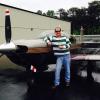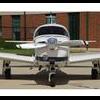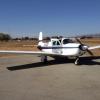Leaderboard
Popular Content
Showing content with the highest reputation on 06/27/2017 in all areas
-
Did quit a bit of flying this weekend. Went to Chehalis Washington for an impromptu FATPNW fly in. Got to meet so pretty cool people and enjoyed the food at the golf course. Flew on down to Troutdale and spent the night with family then flew on home. Got to see N5355Q that I got my license in back in 2005. The 451 nautical miles was a breeze in Freedom. Sent from my iPhone using Tapatalk5 points
-
When I look at the wing during flight nothing seems to be going on out there.4 points
-
After my last annual my injectors must have been cleaned and placed back in random order. That was the worst my bird ever ran in over 10 years of flying LOP. My GAMI spread went from my usual 0.2 up to 0.6 and my #3 EGT was -40 before #4 would go LOP which made the engine slightly rough by the time I got to -10 LOP. We swapped #3 and #4 injectors which were the first and last to go LOP and my GAMI spread is the best it has ever been. I'm getting 0.0 to 0.1 GAMI spread and she runs great with a smooth loss of power going deeper LOP and basically smooth all the way to mixture cutoff. Several times this past week at 8K -11K all four cylinders have gone LOP basically simultaneously so I have been running at peak to -5 LOP. I am very pleased with the results of something that basically didn't even cost me anything and no bad effects on CHTs. As a matter of fact while my TAS is still the same while ROP, I gained 1-2 Kts while LOP due to more power being produced by the leanest cylinder while at the same setting on the last to lean. Thank you to the MS community because I learned to do this by being a member of this forum. If you have the same problem I described, I highly recommend swapping some injectors.3 points
-
Wow! Now I've watched the video. They started with a gross oversimplification of Bernoulli's Law, turned it into a straw man, and proved the straw manto be incorrect. They further compounded their error by expanding from an incorrect / incomplete oversimplification not being fully functional to the whole thing being wrong . . . I can do that with your bank account and prove that you are either getting rich beyond your dreams or going rapidly broke, depending on the assumptions I make in my simplified model and how I apply them. Note that they left that part out . . . Kind of like how so many A&Ps "prove" that running your engine LOP will "burn it up" without presenting any data. Show me the math, with all assumptions clearly stated. Once I go through it and don't find any inconsistent assumptions or things I think are inaccurate, and there are no math errors, then I might believe them. Right now, I stand by my above statement: Bernoulli and Newton both contribute to lift, and they cannot be separated. Others have held this belief for longer than airplanes have been flying, granting both the title of "Law" because they hold pretty much all of the time [although Einstein did a good job showing that relativistic effects must be taken into account as speeds approach c, but aerodynamics are gone well before then . . . ].3 points
-
As someone who had a prop governor fail, I do cycle the governor during runup just to make sure.3 points
-
That photo was taken in 2004, the American Eskimo, Connor, was the greatest dog..loved to fly. He would accompany me on the weekends to I69 (Sportys) where we would visit my GF (now my wife) Alice. He had this intuition when I was going to go fly and would get between me and the car lobbying to go. Sadly, I lost this remarkable dog to coyote's in 2011. Jason and the rest of the Sporty's crew sent me a sympathy card and really did miss Connor. It is because of him I now teach to leave the flaps in TO position when shutting down. It keeps people, even experienced, from stepping on them and allows dogs to jump up onto the wingwalk safely.2 points
-
I would only do them in preparation for a touch and go after a no flap takeoff while LOP.2 points
-
I very much second that when it comes to injectors. If it ain't broke don't fix it.2 points
-
I was in Costco last week and saw their demonstration. It was impressive, but being a CB, I didn't buy into the cost.2 points
-
I was going to come add this in seriousness to the thread. Cycling the oil isn't really that necessary compared to a radial (governor works backwards and a lot more oil) the main purpose is to see that it actually works.2 points
-
Quite a challenge for Magellan to find a passage to the Pacific via the southern tip of South America. This passage "Strait of Magellan" was in use until 1914 when the Panama Canal was completed. Skippers Magellan and Columbus really had guts for exploring the unknown and motivating their crew to follow them.2 points
-
Wow, Clarence, I knew the Comanche 400 was inefficient but never realized it was this bad!2 points
-
Nope. Did the rest of my training out of MMV. Well, private anyway. It was fun, I'd go again. I saw a place I was visiting last week had a t6 you could fly in but didn't have time.2 points
-
I took some early lessons at TDD. Lets see here: 7/12/1997 N704SV 8/8/97 N704PX 9/9/97 N8997U 12/31/97 N7322A Flew a t6 texan out of chehalis once. Love the walmart in the middle of the old runway.,2 points
-
I updated my post from minor to major so we can put the debate to rest.2 points
-
There is an advantage to running LOP with more advanced timing. A lean mixture burns slower than a rich mixture. LOP requires more advance so the maximum pressure happens at the same crank angle as ROP (Approx 15 deg ATDC) . Anybody who says that LOP and 25 degree timing don't mix doesn't know what they are talking about. Besides it is all about temperature, so keep your temps in control and you will be fine.2 points
-
I believe that is where we did the pre-purchase inspection on my Rocket back in 2000. Flew down there from Boeing Field in Seattle. Tom2 points
-
It's been said before; Newtons law makes planes fly, Bernoulli laws makes them fly efficiently.2 points
-
2 points
-
I've had three really bad turbulence experiences, and flying out west year round for close to 30 years - trust me, what would be considered bad in the east is nothing. These are "questioning if you ever want to fly again" turbulence episodes. At 14,500 ft coming back from Sante Fe to Tucson, I had continuous moderate to very regular and repeated severe turbulence the entire route. When I got on the ground, it was the happiest I had been in a long time. That was in a Mooney Bravo. Flying from Tucson to Scottsdale, it was a normal beautiful flight. On downwind to SDL I had the most severe single jolt turbulence of my life. My seatbelt was typical tight, probably could have been a tough tighter but wasn't loose by any means. I hit my head on the ceiling so hard I was bleeding quite a bit and surprised I was still conscious. The tower even called and asked if I was OK. I figured they must have seen something. I pulled the ATC tapes later and realized why they asked if everything was alright. It seems when the turbulence hit I also inadvertently pushed the PTT and on the tape was me staying (very distressed) "oh shit !!!" That was in an F model Mooney. The absolute worst turbulence of my life though was also in the Bravo. I was coming back to Tucson from Las Vegas. I chose to park at North Las Vegas that time, but have only been going into Henderson for years now. I didn't feel like dealing with LAS so I initially went westward under the bravo until clear of it and then climbed. Mt. Charleston is in that area as well as other mountains. And there was a significant, very strong wind from the west. I got the crap beat out of me until I could climb. Staying under the bravo meant below 1,000 AGL, in the summer, in the heat with the tremendous mountain waves coming toward me. One definition of severe turbulence is loss of control of the aircraft and by that definition I had ten episodes of severe turbulence in ten minutes, all below 1,000 AGL. Each episode was no more than two seconds but that was not a fun ride whatsoever !!!2 points
-
2 points
-
1 point
-
1 point
-
I thought that video was oversimplified at best. The demonstration of the Coanda effect ignored capillary action, which was responsible for quite a bit shown. Try pouring some oil over a plastic bottle and you'll see what I mean. The problem is many things in Physics defy simple explanations, and I suspect airfoils are one of them. Unfortunately, simple explanations rule youtube.1 point
-
I am familiar with the rational, it stems from the longer wave RF that was much more susceptible to P-Static. Its also read through the internet for years now the following points that I have seen to evidence to contradict: - At the relatively slow airspeeds of our piston GA fleet that we fly, we are pretty much immune to P-Static - Our modern avionics are much superior at filtering out noise than the old radios - Mooney doesn't install these as standard but gives an option for owners to install them. But merely bolting/screwing on static wicks on top of the painted control surface has been said to be worthless by supposed static wick experts that say the bond between the wick and the control surface needs to be made against bare metal and in addition to screws/rivets they use a very expensive bonding epoxy. This is why the a proper static wick has removable screw in wicks for replacement. Also important to their effectiveness is the need that all control surfaces are also bonded to the airframe. According to these experts most/many wicks installed on GA aircraft are improperly installed and not doing their job anyway. - Not that much of the GA fleet has static wicks installed, but when have you ever heard of a pilot flying that had P-Static interference take out their radios? I don't think Mooneyspace has a single instance of a complaint. (I've even seen a lighting strike hole in a Mooney Wing tip that didn't take out the radios - pilot didn't realize till after landing) - Personally, I think St Elmo's fire is about the only phenomenon we're still exposed too - would wicks matter there? I can't say - never experienced it. But I think the threat of P-Static to our VHF communications and VOR navigation is non-existent just by the sure number of aircraft flying in moisture with out wicks and the lack of complaints. My sense if it ever happens it has to be extremely rare. I raise the question because I wonder if anyone has experienced any p-static with today's modern avionics without them that was a problem. I think they get installed as insurance. But am no expert and therefore just asking.1 point
-
Turns out it is a little more complicated - and interesting: http://www.australia.gov.au/about-australia/australian-story/european-discovery-and-colonisation ... The first records of European mariners sailing into 'Australian' waters occurs around 1606, and includes their observations of the land known as Terra Australis Incognita (unknown southern land). The first ship and crew to chart the Australian coast and meet with Aboriginal people was the Duyfken captained by Dutchman, Willem Janszoon. Between 1606 and 1770, an estimated 54 European ships from a range of nations made contact. Many of these were merchant ships from the Dutch East Indies Company and included the ships of Abel Tasman. Tasman charted parts of the north, west and south coasts of Australia which was then known as New Holland. In 1770, Englishman Lieutenant James Cook charted the Australian east coast in his ship HM Barque Endeavour. Cook claimed the east coast under instruction from King George III of England on 22 August 1770 at Possession Island, naming eastern Australia 'New South Wales'. The coast of Australia, featuring Tasmania as a separate island, was mapped in detail by the English mariners and navigators Bass and Flinders, and the French mariner, Baudin. This period of European exploration is reflected in the names of landmarks such as the Torres Strait, Arnhem Land, Dampier Sound, Tasmania, the Furneaux Islands, Cape Frecinyet and La Perouse. Expeditions between 1790 and the 1830s, led by D'Entrecasteaux, Baudin, and Furneaux, were recorded by the naturalists Labillardire and Pron. ...1 point
-
Correct. Too bad a regional manager for Lycoming doesn't understand engine technology. To expand on N201MKTurbo: the objective should be to get the max cyl pressure at the sweet spot approx 15 degrees after TDC. If earlier, the CHTs rise unacceptably. If later, you waste energy out the exhaust. RPM: given the same mixture, Increasing RPM pushes the peak later. Reducing RPM pushes the peak earlier. Higher RPM also wastes power because of increased internal engine friction. Mixture: Burn rate slows for either richer or leaner than "ideal mixture". If you lean more, the burn slows and pushes the peak later. If you enrichen more you also push the peak later. That's why we enrichen for takeoff. The mixture burns more slowly and pushes peak pressure later, keeping temps down. (excess fuel has nothing to do with it, it's just to slow the burn and delay the pressure peak) ... for those that understand engine dynamics, with more precise and automated control (that we don't currently have), LOP takeoff would also be ok. 20-25 degree advance: with 25, you have the flexibility to use rpm and mixture to get the peak in the right spot. With 20, you have less options and have to get a faster burn to get the peak in the correct spot using excess fuel that doesn't burn completely and pressure also doesn't last as long. Also, the power advantage that people see in fine wires is because of less shielding around the spark that traditional massives have. Fine wires give a larger initial flame front resulting in a marginal advance. BY plugs (in theory) do the same by initiating a flame front deeper in the mixture.1 point
-
Were you going to college at Mt. Hood? How do you like the T6? I got my dad a ride in one last year at Erickson Aircraft Museum. Sent from my iPhone using Tapatalk1 point
-
1 point
-
Lift is really a quantum entanglement issue.....a macro-scale single-slit phenomenon. The air molecules below the airfoil, once realizing that they've been duped into separating from their entangled twin, push up on the bottom of the airfoil in a vane attempt to reunite, in the process creating lift. Special relativity gets involved when there is a 90-degree difference in airflow against the airfoil, as occurs with a downwind turn. In this circumstance, the entangled molecules below the airfoil become ambivalent regarding the particle separation and cease to apply pressure, causing the airfoil to stall, as always occurs when turning downwind. A more serious take on the coolest thing in all of science: https://youtu.be/U7Z_TIw9InA1 point
-
I would love that, ill see if I can get my instructor to sign me off for a solo up there and we can get together soon!1 point
-
I tend to agree with you Paul. I have never had static wicks on my plane and can't say any I have seen a problem created by not having them. Even when I had an ADF, I saw more interference by a lightning storm than by precipitation static. Sent from my iPad using Tapatalk Pro1 point
-
Jetdriven, we can discuss this until we're blue in the face. We all know each FSDO is different in how they want things done. Mine asked for a 337 to be filled out because I altered the fuel system. No field approval required. I was happy to fill out the form and note the work in my logbook and get my airplane back in service quickly.1 point
-
All I know is that the first convicts arrived in 17881 point
-
Back to the subject of T&G's: Don't do them if you're not comfortable with them, but why haven't you become comfortable? T&G's do allow more landings in a shorter amount of time. Prior to the advanced simulators, we did T&G's in single and multi-pilot Navy aircraft. The airline did them for years with new pilots in big and small airplanes. I do them in all the airplanes I've owned, or rented. To me, a T&G is simply a maneuver. Practice and learn until proficient...or not.1 point
-
My lead was actually a M20C, N6578U flown by Anfrew Soleimany, the other Mooney, who is a First Officer for Sky West. I was in the center of my half of the runway for the element landing1 point
-
When winds are high, I try to stay on the windward side of the hills by a fair margin. You pick up a little speed and I imagine the air does water does when it goes over a boulder, so I figure the swirlyness isn't as pronounced on the windward side. I've experienced turbulence in the appalachians that I regarded as kindof fun, where I'd get pushed around at maybe 2-3G, but it was smooth and I could maintain control of the airplane. The worst turbulence I've ever experienced, which was not fun, was on my way to Las Vegas. I'd been pushing a 50kt headwind at 11,000ft just west of ABQ early in the afternoon in October. The ride was pretty smooth and the skies were clear. Suddenly and without warning, it was like a little kid grabbed my airplane and did what kids do when they play with toy airplanes. I was along for the ride. I remember thinking I was done with flying and that I wanted to land immediately and just walk away. I've gotten caught in a buildup at night in Florida where I thought I was penetrating a haze layer at 1500ft. I came out of the side at 9500ft, after what I considered fighting for my life to keep wings level and airspeed at 120, and to put as much distance between myself and the ground as possible. That buildup required full control deflection and I barely remember most of the experience because of the workload. However, it did not compare to what I experienced on a clear day in New Mexico.1 point
-
Alan's @amillet sporting a new avatar photo today! It took me a few seconds to realize why the Mooney was so far from the centerline... Avoiding the tremendous wake-turbulence thrown from the lead brand B ship... Go Formators! Best regards, -a-1 point
-
The worst turbulence I've experienced was northbound through there, starting just before AVL and lasting 25-30 minutes. My track was west of Mt. Mitchell with westerly winds. At least none of my fillings were knocked out. The guy who went to SnF with me said it was also the worst he'd flown through . . . We were expecting some that day, having crossed GA and 6000 until terrain made me climb. Went to 10,000 first, then 11,000, hoping to reduce the shaking, but it didn't help. Usually it's been pretty smooth, but I did get a very relaxed mountain wave once, 200-300 feet above and below cruise altitude.1 point
-
Like Lance says, just don't do them. Instead practice real landings of all kinds and real takeoffs of all kinds and taxi back. After initial training one generally doesn't need to do concentrated landing practice where you are not practicing good habits anyway. There has been way too many touch and go accidents. We won't do them at MAPA PPP training events nor will the Bonanza guys at their BPPs either. Sent from my iPhone using Tapatalk1 point
-
The risk of a gear-up or a prop strike is too high for touch and goes on high performance retractable airplanes for me.1 point
-
Maybe he'll only take a wire transfer from western union! I wouldn't do it. Even if it was true, US CBP would hold it for at least month. Lol. I was once almost had on a Zillow rental a block from the SMO airport. 26th and Pearl. Good communication during the process. Said to be $2600/month all good until they said they were on a trip and the keys would be sent once I wired the money. Turns out the little place ended up renting for $6500/mo!!! At least the listing agent was glad I alerted her. I still felt pretty stupid! -Matt1 point
-
Been touring around a little. Denver to tonopah to Merced for a few days Merced to 0q5 for a couple 0q5 to mfr for a few Mfr to Heber City Utah Then home Wednesday. Haven't taken too many pics but there's a few Messing around with power settings some. Trying to find the balance. We've seen Yosemite, Crater lake, a bunch of water falls, a weird hot spring in a cave that is who knows how deep.1 point
-
1 point
-
One way to tell if it is rigging problem or an engine problem is to check the climb rate. The rigging will have a smaller effect on climb rate than cruise speed and engine power will have a greater effect climb rate than cruise speed. If if you have a decent climb rate, your problem is most likely rigging.1 point
-
You never said at what rpm, mp, altitude, temperature, fuel flow, egt. You didn't even say if it is kias, kcas, ktas, or ground speed. At certain power settings or altitudes, 138kts is great. If you are getting 138kias at sub 75% power in the mid 5-7 thousand feet, that's sounds about right. True airspeed would be around 150 depending on conditions which is normal for a J. There's a chance you are chasing an engine/rigging problem when in reality it's an expectations problem. I typically get 150kts true airspeed on 9gph LOP at most altitudes 2500RPM.1 point









.thumb.png.7c67574d7b28f67b0b4a17760919b1ac.png)







































